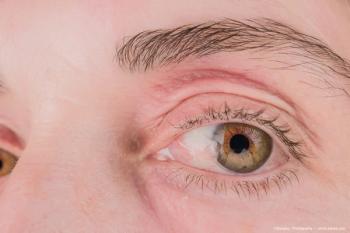
Ocular Therapeutix reaches target enrollment of 555 patients in SOL-R trial
Key Takeaways
- AXPAXLI is a bioresorbable hydrogel incorporating axitinib, targeting wet AMD and other retinal diseases with anti-angiogenic properties.
- The SOL-R trial compares AXPAXLI's six-month dosing to aflibercept's eight-week dosing, focusing on BCVA non-inferiority at week 56.
The trial will be evaluating AXPAXLI dosed every 6 months versus aflibercept (2 mg) dosed every 8 weeks in treatment-naïve wet AMD patients.
The SOL-R registrational trial (NCT06495918) of OTX-TKI (AXPAXLI) by Ocular Therapeutix has reached its randomization target of 555 patients.
The company describes AXPAXLI as an “investigational, bioresorbable, intravitreal hydrogel incorporating axitinib, a small molecule, multi-target, tyrosine kinase inhibitor with anti-angiogenic properties. It is currently being evaluated for the treatment of
The trial is a phase 3, multi-center, double-masked, randomized (2:2:1) trial evaluating AXPAXLI dosed every 6 months versus aflibercept (2 mg) dosed every 8 weeks in treatment-naïve wet AMD patients. Patients are enrolled across approximately 100 sites across the United States, Argentina, India, and Australia.
In the trial, patients in the first arm receive a single dose of AXPAXLI at day 1 and are re-dosed at weeks 24, 48, and 72. Patients in the second arm receive aflibercept (2 mg) on day 1 and per label every 8 weeks. Patients in the third arm receive a single dose of aflibercept (8 mg) at day 1 and are re-dosed at weeks 24, 48, and 72, aligned with the AXPAXLI treatment arm for adequate masking. Patients are followed for safety and will remain masked until the end of year 2.
The primary endpoint of SOL-R is to demonstrate non-inferiority in the mean change in best corrected visual acuity (BCVA) from baseline between the AXPAXLI and on-label aflibercept (2 mg) arms at week 56. The company noted that a singular week 56 primary endpoint in SOL-R is “potentially favorable as subjects will have received their most recent aflibercept or AXPAXLI injection 8 weeks prior, at week 48.”
The company will continue to allow randomization of previously enrolled subjects currently in the loading phase of the trial. During the loading phase, patients receive 2 loading doses of aflibercept (2 mg) prior to day 1.
Pravin U Dugel, MD, executive chairman, president, and CEO of Ocular Therapeutix, commented on the trial in a press release from the company.
“SOL-1 and SOL-R were intentionally developed to complement each other: SOL-1 is designed to demonstrate AXPAXLI’s true durability up to 12 months and enable what could become the first superiority label versus a single dose of anti-VEGF therapy, while SOL-R is designed to provide data supporting the immediate adoption of AXPAXLI into clinical practice with predictable every six-month dosing. Across both trials, we have thoughtfully de-risked our approach to optimize patient selection and ensure rigor in execution,” said Dugel.
Dugel continued on to talk about the design of SOL-R, saying, “SOL-R is the first trial of its kind to include an extensive 6-month screening and loading phase specifically designed to exclude subjects with early persistent fluid or significant retinal fluid fluctuations which can otherwise introduce variability and disrupt non-inferiority trials. This deliberate approach should result in the randomization of a more uniform patient population, thereby de-risking the study and strengthening the reliability of its data.”
SOL-1 is the company’s first registrational trial in wet AMD evaluating a single injection of AXPAXLI versus a single aflibercept (2 mg) injection. The
Pending positive results from SOL-1 and SOL-R, the company noted it plans to submit a New Drug Application (NDA) to the FDA following 56-week topline data from SOL-R.
Most recently, Ocular Therapeutix announced it received written agreement regarding a registrational trial design from the FDA under a Special Protocol Assessment (SPA) for its planned clinical trial of AXPAXLI for the treatment of non-proliferative diabetic retinopathy (NPDR).3
References:
Ocular Therapeutix™ Achieves Target Randomization of 555 Subjects in SOL-R. Published November 4, 2025. Accessed November 4, 2025.
https://www.globenewswire.com/news-release/2025/11/04/3180122/0/en/Ocular-Therapeutix-Achieves-Target-Randomization-of-555-Subjects-in-SOL-R.html Crago SM. Over 300 patients randomized in Ocular Therapeutix's SOL-1 phase 3 trial for OTX-TKI. Published December 4, 2024. Accessed November 4, 2025.
https://www.ophthalmologytimes.com/view/over-300-patients-randomized-in-ocular-therapeutix-sol-1-phase-3-trial-for-otx-tki Harp MD. Ocular Therapeutix receives FDA agreement under special protocol assessment for registrational trial of AXPAXLI. Published August 13, 2025. Accessed Novemner 4, 2025.
https://www.ophthalmologytimes.com/view/ocular-therapeutix-receives-fda-agreement-under-special-protocol-assessment-for-registrational-trial-of-axpaxli
Newsletter
Don’t miss out—get Ophthalmology Times updates on the latest clinical advancements and expert interviews, straight to your inbox.













































.png)


